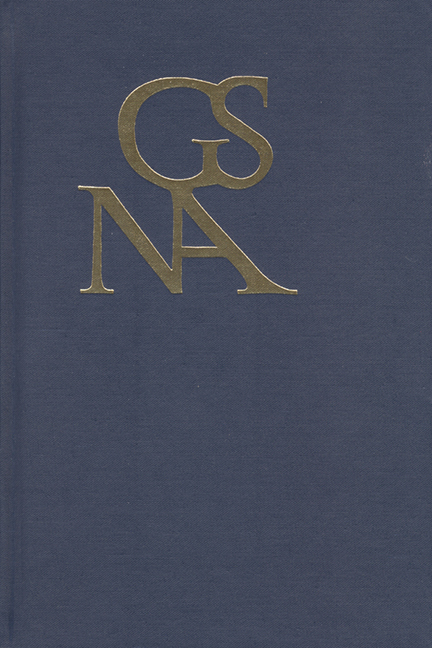Book contents
- Frontmatter
- Contents
- Reorientations around Goethe
- Reorientations around Goethe II
- Special Section on Goethe's Narrative Events edited by Fritz Breithaupt
- What Is an Event for Goethe?
- Much Ado about Nothing? The Absence of Events in Die Wahlverwandtschaften
- Countering Catastrophe: Goethe's Novelle in the Aftershock of Heinrich von Kleist
- Narrating (against) the Uncanny: Goethe's “Ballade” versus Hoffmann's Der Sandmann
- Remembering Klopstock's Mitausdruck
- Strategic Indecision: Gender and Bureaucracy in Schiller's Maria Stuart
- The Dark Green in the Early Anthropocene: Goethe's Plants in Versuch die Metamorphose der Pflanzen zu erklären and Triumph der Empfindsamkeit
- Abschlussbewegungen: Goethe, Freud, and Spectral Forms of Life
- Ein Mythos und sein doppelter Entzug des Modernen: Prämissen für einen Ausweg aus der Unübersichtlichkeit der Faustforschung
- Johann Wolfgang von Goethe in Conversation with Things
- World Literature Turns Political, 1835/36: The Early Afterlife of Goethe's Pronouncement in German Cultural-Politics and in the Young Germany Movement
- Fritz Strich and the Dilemmas of World Literature Today
- A Jewish Faust Commentary: Notes on Franz Rosenzweig's The Star of Redemption
- From Idylle to idílio: Mário de Andrade's Parody of Hermann und Dorothea
- Koselleck's Timely Goethe?
- Book Reviews
Narrating (against) the Uncanny: Goethe's “Ballade” versus Hoffmann's Der Sandmann
from Special Section on Goethe's Narrative Events edited by Fritz Breithaupt
Published online by Cambridge University Press: 26 June 2019
- Frontmatter
- Contents
- Reorientations around Goethe
- Reorientations around Goethe II
- Special Section on Goethe's Narrative Events edited by Fritz Breithaupt
- What Is an Event for Goethe?
- Much Ado about Nothing? The Absence of Events in Die Wahlverwandtschaften
- Countering Catastrophe: Goethe's Novelle in the Aftershock of Heinrich von Kleist
- Narrating (against) the Uncanny: Goethe's “Ballade” versus Hoffmann's Der Sandmann
- Remembering Klopstock's Mitausdruck
- Strategic Indecision: Gender and Bureaucracy in Schiller's Maria Stuart
- The Dark Green in the Early Anthropocene: Goethe's Plants in Versuch die Metamorphose der Pflanzen zu erklären and Triumph der Empfindsamkeit
- Abschlussbewegungen: Goethe, Freud, and Spectral Forms of Life
- Ein Mythos und sein doppelter Entzug des Modernen: Prämissen für einen Ausweg aus der Unübersichtlichkeit der Faustforschung
- Johann Wolfgang von Goethe in Conversation with Things
- World Literature Turns Political, 1835/36: The Early Afterlife of Goethe's Pronouncement in German Cultural-Politics and in the Young Germany Movement
- Fritz Strich and the Dilemmas of World Literature Today
- A Jewish Faust Commentary: Notes on Franz Rosenzweig's The Star of Redemption
- From Idylle to idílio: Mário de Andrade's Parody of Hermann und Dorothea
- Koselleck's Timely Goethe?
- Book Reviews
Summary
The Aesthetic Uncanny, or: Why Children Need Stories
SIGMUND FREUD OPENED his famous essay “Das Unheimliche” (“The Uncanny”) with the gesture of acknowledging his unease about the quasi-uncanny intrusion he was about to commit by venturing into a domain outside the field of his psychoanalytical expertise: “the subject of aesthetics.” He committed this transgression nonetheless and featured E. T. A. Hoffmann's story of Der Sandmann (The Sandman) as his primary case study to examine a series of motifs that have been labeled as “uncanny” in literature. However, at the end of his excursion into what was foreign territory to him, Freud redrew the strict line of demarcation between a psychoanalytic and aesthetic inquiry of the uncanny:
We might say that these preliminary results have satisfied psycho-analytic interest in the problem of the uncanny, and that what remains probably calls for an aesthetic enquiry. But that would be to open the door to doubts about what exactly is the value of our general contention that the uncanny proceeds from something familiar which has been repressed. (246)
This is a surprising, if not self-contradictory conclusion of the essay, because Freud took both the examples that supported as well as those that contradicted his theory from the realm of literature. By admitting to suppressing his rising doubts about the value of his results and closing the door to an aesthetic inquiry, he intentionally exposed his essay to the possibility of a haunting return—that of his repressed doubts in the form of future criticism. This article aims to reopen the door that Freud closed and to challenge, or at least complement, his psychoanalytical approach with an aesthetic inquiry.
What kind of “doubts” Freud had in mind becomes evident when we consult the rivaling theory of Ernst Jentsch from 1906, who defined the uncanny as “intellectual” or “psychical uncertain[ty]” for distinguishing between the real and imagined, and as “doubt as to whether an apparently living being is animate and, conversely, doubt as to whether a lifeless object may not in fact be animate.”
- Type
- Chapter
- Information
- Goethe Yearbook 26Publications of the Goethe Society of North America, pp. 79 - 100Publisher: Boydell & BrewerPrint publication year: 2019



